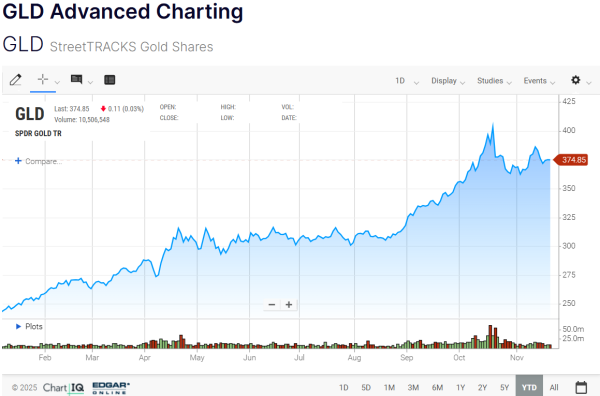Gold’s rise in 2025 has become one of the most surprising financial stories of the year, and brokers at Nexdi say many investors are only beginning to understand the implications. While equities have delivered respectable returns and AI-linked stocks continue to dominate headlines, the precious metal has quietly staged a performance that is both historic and revealing.
In a period marked by political friction, widening fiscal deficits, and persistent questions about global currency stability, gold has delivered a stunning 56% gain, dramatically outperforming the S&P 500, Nasdaq-100, and even the explosive rally in Nvidia. For investors looking for stability in a deeply uncertain landscape, this surge is more than a short-term anomaly; it signals a renewed appetite for stores of value as traditional economic anchors appear increasingly fragile.
Why Gold Is Outperforming Everything in 2025
The metal’s impressive run is rooted in a combination of economic, political, and historical factors that have converged simultaneously.
1. Gold as a Timeless Store of Value
Gold’s strength originates from its scarcity and its centuries-long role as a preservation asset. Only 216,000 metric tons of gold have ever been mined, a fraction of silver and negligible compared to other extractable commodities. Its limited supply has historically made it a natural hedge during periods when fiat currencies face pressure.
2. A Weakening Dollar and Explosive Debt Growth
Perhaps the most important catalyst is the deterioration of U.S. fiscal conditions.
- The U.S. dollar has lost nearly 90% of its purchasing power since the end of the gold standard in 1971.
- The national debt recently hit $38 trillion, with a single-year deficit of $1.8 trillion.
This combination amplifies inflation anxiety, pushing investors toward assets that cannot be devalued by government policy. With fears rising that the U.S. will need to expand its money supply aggressively to service growing obligations, gold has reasserted itself as a stable alternative.
3. Global Instability Is Fueling Demand
Geopolitical tensions and persistent uncertainty over central-bank policy have added fuel to the rally. In challenging macro environments, capital naturally gravitates toward physical assets, and in 2025, gold has once again become a favored safe-haven.

The Appeal of Gold: A Simple Hedge Against a Complex World
Gold’s appeal lies in its low correlation to traditional risk assets. It generates no earnings and pays no dividends, yet this simplicity is precisely why it becomes so valuable during chaotic periods.
Gold does not depend on corporate profits, consumer spending, interest-rate decisions, or economic forecasts, making it a pure hedge against currency erosion and systemic instability. Its price also tends to track money-supply expansion over the long term. As governments print more, gold inherently becomes more valuable in comparison.
Practical Challenges of Owning Physical Gold
Despite its strengths, owning physical gold presents several logistical challenges. Investors must contend with storage and security costs, as well as insurance requirements to protect their holdings.
Selling large quantities can also be difficult and time-consuming, and physical gold generally offers limited liquidity compared to financial instruments like ETFs or mutual funds. These factors make physical ownership less appealing for diversified investors or those who require flexibility in managing their portfolios.
The SPDR Gold Trust: The Easiest Way to Gain Exposure
A Widely Accessible Option
For many investors, the SPDR Gold Trust (GLD) offers a streamlined way to capture gold’s upside. The ETF is backed by physical reserves and moves nearly in lockstep with the commodity’s spot price.
Key advantages include:
- High liquidity
- No need for secure storage
- Fast execution, buy or sell with a click
- Broad availability across brokerage platforms
Costs to Consider
GLD charges an annual expense ratio of 0.4%. For large portfolios, that cost can add up, though it will still be significantly lower than the combined expenses of storing and insuring physical gold.
Limitations During Extreme Scenarios
A key point investors should understand is that even though the ETF is fully backed by metal, shareholders have no claim to the physical gold. In a true systemic breakdown where financial systems become inaccessible, physical bullion would outperform. For typical market conditions, however, GLD remains a highly efficient tool.

Should Investors Add Gold Now?
Gold’s 56% return in 2025 is far above its long-term average of around 8%. While the metal may not continue rising at this pace, the macro forces supporting it, debt expansion, geopolitical instability, and inflation risk, remain firmly in place.
For most investors, gold should not replace a diversified portfolio, but it can serve as an effective hedge when traditional assets face pressure.








